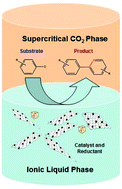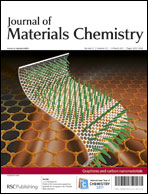An economical and green pathway: graphene oxide (GO)-supported palladium nanoparticles (Pd NPs) catalyzed a reductive Ullmann reaction of aryl chloride towards biaryl with high conversion and selectivity in ionic liquid (IL)–supercritical carbon dioxide (ScCO2). The combination of IL and ScCO2 provides superior advantages in product separation, catalyst recycling and reuse of the reaction media over traditional organic solvents. Further investigations showed that GO, the novel catalyst support bearing abundant carboxylic, hydroxyl, epoxy and aldehyde groups, can replace the traditional active hydrogen donor readily with much enhanced product separation efficiency. The use of IL, e.g.[hmim][Tf2N], led to obvious improved stability of the Pd NPs, which was helpful for catalyst recycling. Carbon dioxide, a naturally abundant, nonflammable, relatively nontoxic, economical and recyclable “greenhouse” gas, was found to significantly promote the selectivity of the graphene oxide-based Pd NP-catalyzed reductive Ullmann reaction of aryl chloride. Investigations showed that the Pd NP catalyst and IL can be recycled for more than 5 runs without obvious loss of conversion, indicating the economical viability of this process.

You have access to this article
 Please wait while we load your content...
Something went wrong. Try again?
Please wait while we load your content...
Something went wrong. Try again?


 Please wait while we load your content...
Please wait while we load your content...